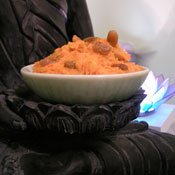I consider cooking an act of devotion. I don't bow in front of my stovetop (although I've considered full prostration in front of my stand mixer), but creating food that nourishes bodies is my way to connect and share love with friends and family. I dote on ingredients and pour myself into their preparation, wanting my guests to enjoy the food and know that care and thought went into the process.
While pots and pans aren't a part of my yoga practice, the same principles I employ in the kitchen apply to my time spent on the mat: both demand focus, technique, improvisation and a heart intent on offering up the best one has.
I didn't do much cooking last week because I participated in a 30-hour training with yoga teachers from all over the Southeast. We worked together to deliberately step outside our comfort zones to find our strengths and weaknesses, and to become better teachers through exposure to each other's methods. These sorts of intensive studies require a degree of vulnerability and openness that's not normally required of us in our day-to-day lives.
Through shared practice and learning, we often form deep friendships in a short period of time. Some yoga traditions call this by the Sanskrit word kula, or "community of the heart." I've been party to this sort of quick-bonding at sci-fi/fantasy conventions: since we geeks congregate out of our love for the genre, there's an instant common thread and camaraderie that can make forging a friendship easier.
Shifting back into daily life is difficult because leaving a community of peers is depressing. Very few people might speak your language, whether it's Batman or Hanuman. I came home to write about food, and felt trivialuntil I came up with the idea to cook Carrot Halwa, an Indian dessert, in homage to the community I'd just left.
Halwa (from the Arabic word for "sweet") is an ubiquitous dessert found in Central and South Asia and the Middle East. What I love best about halwa is that it's made of whatever's handy: Grains, nuts, fruits, legumes and even gourds are fair game. The textures are just as varied. Halwa can be doughy, crumbly, gelatinous or even succulent, like candied fruit.
If you're after a throw-together dessert, look elsewhere; halwa is a labor-intensive dish. As a result, I had plenty of time to process my thoughts about what I'd learned, the people with whom I'd nearly spent a work week, and about how the resulting dish embodied my experience.
It takes willpower and muscle to grate a pound and a half of carrots, but the imperfection of hand-grating gives it added texture and depth. Cooking halwa requires patience and focus because seeing each stage through to its completion before proceeding to the next is crucial to the final outcome.
Like kula, it's a melding of deep contrasts: firm shreds of carrot and ghee-plumped raisins, the sharp bite of ginger and cardamom against the creaminess of the thickened milk. It's peppered liberally with nuts, so in that way, it is also very much like my idea of kula. Feed this to people who inspire, challenge and support you as you follow your bliss.
Gajar Ka Halwa (Carrot "Pudding" with Ginger and Cardamom)
Serves 4-6
1/3 cup ghee, divided*
1/3 cup golden raisins
1/3 cup unsalted cashews, chopped
1 and 1/2 pounds carrots, peeled and coarsely grated
2 cups whole milk
1 teaspoon ground cardamom
1/2 cup sugar
2 tablespoons minced crystallized ginger
In a large, deep saucepan, fry the cashews in 2 teaspoons ghee on medium heat until fragrant and golden. (*If you don't have ghee on hand, patiently melt one stick butter on low heat until the milk solids separate from the oil. Strain and use.) Remove the cashews, add another teaspoon of ghee and fry the raisins until they're fully plumped and their color deepens. Remove and set aside the raisins and any remaining ghee.
Increase the heat to medium-high, and add carrots, cardamom and milk. Stir frequently, until the liquid is reduced by two thirds. Add sugar and stir constantly until the remaining liquid thickens into a clingy syrup.
Add remaining ghee in stages, stirring to incorporate. As the flavors meld, the halwa's color will deepen, and you won't see any evidence of liquid at the bottom of the pan. When the halwa looks glossy and sticky, remove it from the heat. Fold in the ginger, raisins and cashews until distributed evenly, and allow flavors to meld as the mixture cools to room temperature.
Serve warm in tiny bowls.
Previous Comments
- ID
- 151276
- Comment
Pro Tip: if you are making this for yourself instead of a crowd, don't halve the recipe: maximize your effort and freeze the remainder in individual servings. An ice cream scoop is ideal for doling out perfect portions.
- Author
- Deirdra Harris Glover
- Date
- 2009-08-26T20:47:33-06:00
- ID
- 151306
- Comment
YUM. This sounds so delicious, I'm going to be trying it very soon!
- Author
- andi
- Date
- 2009-08-27T13:18:24-06:00



Comments
Use the comment form below to begin a discussion about this content.
comments powered by Disqus